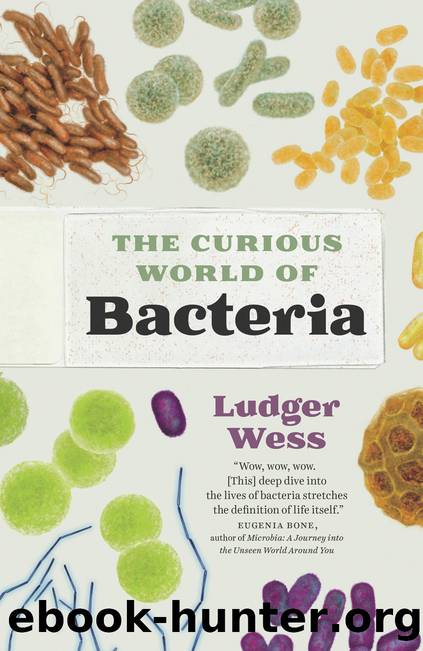The Curious World of Bacteria by Ludger Wess

Author:Ludger Wess
Language: eng
Format: epub
Publisher: Greystone Books
Published: 2023-05-15T00:00:00+00:00
Chromulinavorax destructans
Destructive golden algae devourer
(in golden alga, nine hours after infection)
Shape: Spherical
Diameter: 350 to 400 nm (nanometers)
CHROMULINAVORAX DESTRUCTANS is a kind of zombie bacterium, bobbing around as an undead in the freshwater environments of our planet. It shows no signs of metabolic activity, so it neither grows, nor divides, nor multiplies. All this changes when it is swallowed by the golden alga Spumella elongata, one of the most common golden algae on Earth that swims in water and lives on bacteria, viruses, and protozoa. Once swallowed, C. destructans springs to life and begins eating its victim from the inside out. Microbiologists have aptly named it the destructive golden algae devourer.
It is the alga, not the parasite, that initially does the devouring. S. elongata surrounds the bacterium with a small protrusion and guides the bacterium inward to digest its contents. But C. destructans blocks this process and takes control of the algaâs metabolism. In just three hours, the algaâs mitochondria have gathered around the vesicle containing C. destructans, and they supply the energy for this zombie bacterium to use the algaâs cell components for its own growth and rapid cell division. After twelve hours, two-thirds of the alga is filled with new bacteria, and after another six hours, the alga bursts, releasing the new bacteria into the environment.
Analysis of the genome showed that the bacterium doesnât have a single complete metabolic pathway, meaning that it canât itself produce any of the building blocks necessary to make proteins, genes, carbohydrates, or fats. It can only destroy and remodel already available resources.
This bacterium has a lot in common with a virusâit can only multiply in particular cells and is completely inactive outside of its host. The important difference is that, unlike viruses, C. destructans is not dependent on the hostâs cellular apparatus to replicate its genetic material.
When scientists first discovered this remarkable bacterium, which belongs to an equally strange phylum called Dependentiae (the plural of dependentia, Latin for âdependenceâ), they conducted a systematic search for unknown sequences in RNA libraries and soil samples. The researchers had some success, continued searching, and eventually found the same or highly similar gene sequences in sewage, in hot springs, and in biofilms coating shower heads, water pipes, and sinks. Rather like archaeologists reconstructing texts from fragments of papyrus, the researchers were able to use computers to assemble and evaluate genes and genomes from the sequences. These analyses showed that members of this new phylum had to be parasitic bacteria, that they had comparatively few genes for metabolic enzymes, but that they had many genes for transport proteins, so they apparently lived at the expense of other organisms. Other genes suggested that the host was most likely to be a single-celled eukaryotic organism. At this time, however, the researchers hadnât even found any of these strange bacteria!
This happened once the researchers turned their attention to single-celled organisms that were present in the habitats where the genetic material was found. They determined that the host organisms had to be
Download
This site does not store any files on its server. We only index and link to content provided by other sites. Please contact the content providers to delete copyright contents if any and email us, we'll remove relevant links or contents immediately.
Sapiens: A Brief History of Humankind by Yuval Noah Harari(13052)
The Tidewater Tales by John Barth(12029)
Do No Harm Stories of Life, Death and Brain Surgery by Henry Marsh(6336)
Mastermind: How to Think Like Sherlock Holmes by Maria Konnikova(6234)
The Thirst by Nesbo Jo(5785)
Why We Sleep: Unlocking the Power of Sleep and Dreams by Matthew Walker(5641)
Sapiens by Yuval Noah Harari(4536)
Life 3.0: Being Human in the Age of Artificial Intelligence by Tegmark Max(4507)
The Longevity Diet by Valter Longo(4445)
The Rules Do Not Apply by Ariel Levy(3905)
The Immortal Life of Henrietta Lacks by Rebecca Skloot(3826)
The Body: A Guide for Occupants by Bill Bryson(3800)
Why We Sleep by Matthew Walker(3771)
Animal Frequency by Melissa Alvarez(3755)
Yoga Anatomy by Kaminoff Leslie(3701)
Barron's AP Biology by Goldberg M.S. Deborah T(3631)
The Hacking of the American Mind by Robert H. Lustig(3579)
All Creatures Great and Small by James Herriot(3515)
Yoga Anatomy by Leslie Kaminoff & Amy Matthews(3394)
